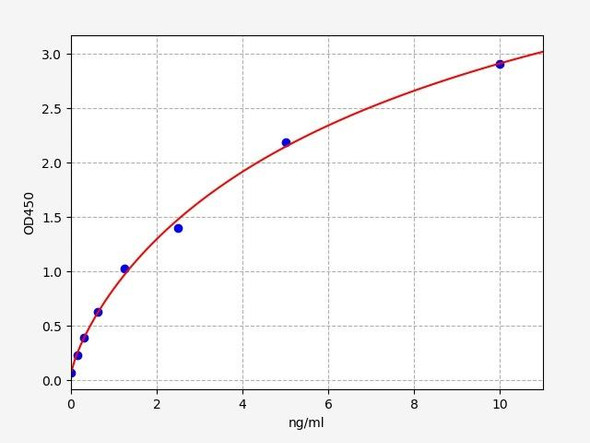Human NR3C1 / Glucocorticoid Receptor ELISA Kit (HUFI01538)
- SKU:
- HUFI01538
- Product Type:
- ELISA Kit
- Size:
- 96 Assays
- Uniprot:
- P04150
- Sensitivity:
- 18.75pg/ml
- Range:
- 31.25-2000pg/ml
- ELISA Type:
- Competitive
- Synonyms:
- NR3C1, Glucocorticoid receptor, GR, Nuclear receptor subfamily 3 group C member 1, GRL, GCR, GCCR
- Reactivity:
- Human
- Research Area:
- Cell Death
Description
Human NR3C1/Glucocorticoid Receptor ELISA Kit
The Human NR3C1 (Glucocorticoid Receptor) ELISA Kit is a reliable and sensitive tool for the quantitative detection of glucocorticoid receptor levels in human samples such as serum, plasma, and cell culture supernatants. This kit offers high specificity and accuracy, providing consistent and trustworthy results for various research purposes.The glucocorticoid receptor plays a critical role in mediating the physiological responses to stress and regulating various metabolic processes in the body. Dysregulation of the glucocorticoid receptor has been linked to numerous diseases, including inflammatory disorders, immune system dysfunction, and mental health conditions.
By accurately measuring glucocorticoid receptor levels, researchers can gain valuable insights into the role of this receptor in different pathophysiological processes and potential therapeutic interventions. The Human NR3C1 ELISA Kit is a valuable tool for studying the mechanisms underlying these conditions and developing targeted therapies to modulate glucocorticoid receptor activity.
| Product Name: | Human NR3C1 / Glucocorticoid Receptor ELISA Kit |
| Product Code: | HUFI01538 |
| Size: | 96 Assays |
| Alias: | NR3C1, Glucocorticoid receptor, GR, Nuclear receptor subfamily 3 group C member 1, GRL, GCR, GCCR |
| Detection method: | Competitive ELISA, Coated with Antibody |
| Application: | This immunoassay kit allows for the in vitro quantitative determination of Human NR3C1 concentrations in serum plasma and other biological fluids. |
| Sensitivity: | 18.75pg/ml |
| Range: | 31.25-2000pg/ml |
| Storage: | 4°C for 6 months |
| Note: | For Research Use Only |
| Recovery: | Matrices listed below were spiked with certain level of Human NR3C1 and the recovery rates were calculated by comparing the measured value to the expected amount of Human NR3C1 in samples. | ||||||||||||||||
| |||||||||||||||||
| Linearity: | The linearity of the kit was assayed by testing samples spiked with appropriate concentration of Human NR3C1 and their serial dilutions. The results were demonstrated by the percentage of calculated concentration to the expected. | ||||||||||||||||
| |||||||||||||||||
| CV(%): | Intra-Assay: CV<8% Inter-Assay: CV<10% |
| Component | Quantity | Storage |
| ELISA Microplate(Dismountable) | 8×12 strips | 4°C for 6 months |
| Lyophilized Standard | 2 | 4°C/-20°C |
| Sample/Standard Dilution Buffer | 20ml | 4°C |
| Biotin-labeled Antibody(Concentrated) | 60ul | 4°C (Protect from light) |
| Antibody Dilution Buffer | 10ml | 4°C |
| HRP-Streptavidin Conjugate(SABC) | 120ul | 4°C (Protect from light) |
| SABC Dilution Buffer | 10ml | 4°C |
| TMB Substrate | 10ml | 4°C (Protect from light) |
| Stop Solution | 10ml | 4°C |
| Wash Buffer(25X) | 30ml | 4°C |
| Plate Sealer | 5 | - |
Other materials and equipment required:
- Microplate reader with 450 nm wavelength filter
- Multichannel Pipette, Pipette, microcentrifuge tubes and disposable pipettetips
- Incubator
- Deionized or distilled water
- Absorbent paper
- Buffer resevoir
| Uniprot | P04150 |
| UniProt Protein Function: | GR: transcription factor of the nuclear receptor family. Receptor for glucocorticoids (GC). Binds to glucocorticoid response elements (GRE) and modulates other transcription factors. Affects inflammatory responses, cellular proliferation and differentiation in target tissues. Three alternatively spliced isoforms have been described. |
| UniProt Protein Details: | Protein type:Mitochondrial; DNA-binding; Transcription factor; Nuclear receptor Chromosomal Location of Human Ortholog: 5q31.3 Cellular Component: cytoplasm; cytosol; membrane; mitochondrial matrix; nucleoplasm; nucleus Molecular Function:glucocorticoid receptor activity; protein binding; protein dimerization activity; steroid binding; transcription factor activity; zinc ion binding Biological Process: adrenal gland development; chromatin modification; gene expression; glucocorticoid mediated signaling; glucocorticoid metabolic process; glucocorticoid receptor signaling pathway; maternal behavior; positive regulation of neuron apoptosis; positive regulation of transcription from RNA polymerase II promoter; regulation of glucocorticoid biosynthetic process; regulation of gluconeogenesis; regulation of transcription, DNA-dependent; signal transduction; transcription from RNA polymerase II promoter; transcription initiation from RNA polymerase II promoter; transcription, DNA-dependent Disease: Glucocorticoid Resistance, Generalized |
| NCBI Summary: | This gene encodes glucocorticoid receptor, which can function both as a transcription factor that binds to glucocorticoid response elements in the promoters of glucocorticoid responsive genes to activate their transcription, and as a regulator of other transcription factors. This receptor is typically found in the cytoplasm, but upon ligand binding, is transported into the nucleus. It is involved in inflammatory responses, cellular proliferation, and differentiation in target tissues. Mutations in this gene are associated with generalized glucocorticoid resistance. Alternative splicing of this gene results in transcript variants encoding either the same or different isoforms. Additional isoforms resulting from the use of alternate in-frame translation initiation sites have also been described, and shown to be functional, displaying diverse cytoplasm-to-nucleus trafficking patterns and distinct transcriptional activities (PMID:15866175). [provided by RefSeq, Feb 2011] |
| UniProt Code: | P04150 |
| NCBI GenInfo Identifier: | 121069 |
| NCBI Gene ID: | 2908 |
| NCBI Accession: | P04150.1 |
| UniProt Secondary Accession: | P04150,P04151, Q53EP5, Q6N0A4, A0ZXF9, B0LPG8, D3DQF4 |
| UniProt Related Accession: | P04150 |
| Molecular Weight: | 82,904 Da |
| NCBI Full Name: | Glucocorticoid receptor |
| NCBI Synonym Full Names: | nuclear receptor subfamily 3 group C member 1 |
| NCBI Official Symbol: | NR3C1 |
| NCBI Official Synonym Symbols: | GR; GCR; GRL; GCCR; GCRST |
| NCBI Protein Information: | glucocorticoid receptor |
| UniProt Protein Name: | Glucocorticoid receptor |
| UniProt Synonym Protein Names: | Nuclear receptor subfamily 3 group C member 1 |
| Protein Family: | Glucocorticoid receptor |
| UniProt Gene Name: | NR3C1 |
| UniProt Entry Name: | GCR_HUMAN |
*Note: Protocols are specific to each batch/lot. For the correct instructions please follow the protocol included in your kit.
Equilibrate the TMB substrate for at least 30 min at 37°C beforeuse. When diluting samples and reagents, they must be mixed completely andevenly. It is recommended to plot a standard curve for each test.
| Step | Protocol |
| 1. | Set standard, test sample and control (zero) wells on the pre-coatedplate respectively, and then, record their positions. It isrecommended to measure each standard and sample in duplicate. Washplate 2 times before adding standard, sample and control (zero) wells! |
| 2. | Add Sample and Biotin-detection antibody: Add 50µL of Standard, Blank or Sample per well. The blankwell is added with Sample Dilution Buffer. Immediately add 50 µL of biotin-labelled antibody workingsolution to each well. Cover with the plate sealer provided. Gently tap the plate to ensure thoroughmixing. Incubate for 45 minutes at 37°C. (Solutions are added to the bottom of micro-ELISA platewell, avoid touching plate walls and foaming). |
| 3. | Wash: Aspirate each well and wash, repeating the process three timesWash by filling each well with Wash Buffer (approximately 350µL)using a squirt bottle, multi-channel pipette, manifold dispenser orautomated washer. Complete removal of liquid at each step is essentialto good performance. After the last wash, remove any remaining WashBuffer by aspirating or decanting. Invert the plate and pat it againstthick clean absorbent paper. |
| 4. | HRP-Streptavidin Conjugate(SABC): Add 100µL of SABC workingsolution to each well. Cover with a new Plate sealer. Incubate for30minutes at 37°C. |
| 5. | Wash: Repeat the aspiration/wash process for five times. |
| 6. | TMB Substrate: Add 90µL of TMB Substrate to each well. Coverwith a new Plate sealer. Incubate for about 10-20 minutes at 37°C.Protect from light. The reaction time can be shortened or extendedaccording to the actual color change, but not more than 30minutes.When apparent gradient appeared in standard wells, you can terminatethe reaction. |
| 7. | Stop: Add 50µL of Stop Solution to each well. Color turn toyellow immediately. The adding order of stop solution should be as thesame as the substrate solution. |
| 8. | OD Measurement: Determine the optical density (OD Value) of each wellat once, using a microplate reader set to 450 nm. You should open themicroplate reader ahead, preheat the instrument, and set the testing parameters. |
When carrying out an ELISA assay it is important to prepare your samples in order to achieve the best possible results. Below we have a list of procedures for the preparation of samples for different sample types.
| Sample Type | Protocol |
| Serum | If using serum separator tubes, allow samples to clot for 30 minutes at room temperature. Centrifuge for 10 minutes at 1,000x g. Collect the serum fraction and assay promptly or aliquot and store the samples at -80°C. Avoid multiple freeze-thaw cycles. If serum separator tubes are not being used, allow samples to clot overnight at 2-8°C. Centrifuge for 10 minutes at 1,000x g. Remove serum and assay promptly or aliquot and store the samples at -80°C. Avoid multiple freeze-thaw cycles. |
| Plasma | Collect plasma using EDTA or heparin as an anticoagulant. Centrifuge samples at 4°C for 15 mins at 1000 × g within 30 mins of collection. Collect the plasma fraction and assay promptly or aliquot and store the samples at -80°C. Avoid multiple freeze-thaw cycles. Note: Over haemolysed samples are not suitable for use with this kit. |
| Urine & Cerebrospinal Fluid | Collect the urine (mid-stream) in a sterile container, centrifuge for 20 mins at 2000-3000 rpm. Remove supernatant and assay immediately. If any precipitation is detected, repeat the centrifugation step. A similar protocol can be used for cerebrospinal fluid. |
| Cell culture supernatant | Collect the cell culture media by pipette, followed by centrifugation at 4°C for 20 mins at 1500 rpm. Collect the clear supernatant and assay immediately. |
| Cell lysates | Solubilize cells in lysis buffer and allow to sit on ice for 30 minutes. Centrifuge tubes at 14,000 x g for 5 minutes to remove insoluble material. Aliquot the supernatant into a new tube and discard the remaining whole cell extract. Quantify total protein concentration using a total protein assay. Assay immediately or aliquot and store at ≤ -20 °C. |
| Tissue homogenates | The preparation of tissue homogenates will vary depending upon tissue type. Rinse tissue with 1X PBS to remove excess blood & homogenize in 20ml of 1X PBS (including protease inhibitors) and store overnight at ≤ -20°C. Two freeze-thaw cycles are required to break the cell membranes. To further disrupt the cell membranes you can sonicate the samples. Centrifuge homogenates for 5 mins at 5000xg. Remove the supernatant and assay immediately or aliquot and store at -20°C or -80°C. |
| Tissue lysates | Rinse tissue with PBS, cut into 1-2 mm pieces, and homogenize with a tissue homogenizer in PBS. Add an equal volume of RIPA buffer containing protease inhibitors and lyse tissues at room temperature for 30 minutes with gentle agitation. Centrifuge to remove debris. Quantify total protein concentration using a total protein assay. Assay immediately or aliquot and store at ≤ -20 °C. |
| Breast Milk | Collect milk samples and centrifuge at 10,000 x g for 60 min at 4°C. Aliquot the supernatant and assay. For long term use, store samples at -80°C. Minimize freeze/thaw cycles. |






